GATEWAY OF INDIA
The Gateway of India, which graces
the locally known Apollo Bunder Pier, was designed by George
Witiet to commemorate George V and Queen Mary's visit to India
in 191 1. It was inspired by 16th Century Gujarati architecture.
From here one can take launch cruises. A launch service
is also available to take people on expeditions to the 6th
Century Caves of Elephanta. Nearest station is Churchgate
(Western Railway).
|
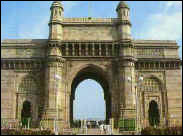 |
PRINCE OF WALES
MUSEUM
The PrinceofWales Museum was designed
by George Wittet and completed in 1914. Built in the grand
Indo-Saracenic style from locally quarried yellow and blue
basalt and topped with a Bijapur style dome, it stands in
beautiful gardens. Nearest station is Churchgate (Western
Railway) or C.S.T (V.T) (Central Railway).
|
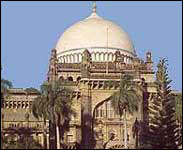 |
JEHANGIR
ART GALLERY
Built in 1952 and situated at Kala
Ghoda, adjacent to the Prince of Wales Museum, the Jehangir
Art Gallery is the most prestigious and modern venue for Indian
artists to exhibit their talent. The Samovar Coffee Terrace
that faces the Museum gardens is a popular hangout for local
artists. Nearest station is Churchgate (Western Railway) or
C.S.T (V.T) (Central Railway).
|
RAJABAI CLOCK
TOWER
One of Mumbai's outstanding landmarks,
the Rajabai Clock Tower is stuated in the gardens of Mumbai
University. Based on plans by George Gilbert Scott and completed
in the 1870's, it is said to have been inspired by Giotto's
Campanile in Florence. It houses the University Library, which
was endowed by a Hindu businessman, Premchand Raichand, in
memory of his mother Rajabai. It is 280 feet tall with five
storeys and at a height of 30 feet, there are eight statues
representing the Indian castes. The tower clock is reported
to have played 16 tunes including'Rule Britannia'. Nearest
station is Churchgate (Western Railway).
|
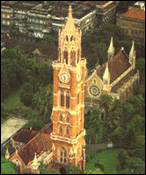 |
FLORA FOUNTAIN
Also known as Hutatma Chowk, Flora
Fountain is a statue of the Roman Goddess of Spring erected
in 1869 in memory of British Governor Sir Bartle Frere. Frere
was responsible for the demolition of the Fort walls in 1864.
It remains a major downtown landmark in Mumbai's business
centre. Nearest station is Churchgate (Western Railway).
|
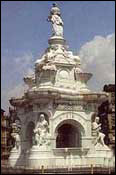 |
FASHION
STREET
This bazaar of export surplus cotton
and inexpensive ready mades is for one and all. They sell
latest fashion clothes at very reasonable prices. It is advisable
to check the clothes before payment. Bargaining is expected.
Nearest station is Churchgate (Western Railway) and C.S.T
(Central Railway).
|
MANTRALAYA
This modern style building houses the
offices of the Government of Maharashtra. Near this building
at a little distance is Yogakshema and the offices of Life
Insurance Corp. Nearest station is Churchgate (Western Railway).
|
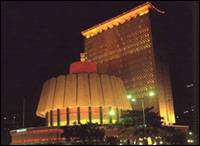 |
VICTORIA TERMINUS
V.T is now known as Chhatrapati Shivaji
Terminus (C.S.T) and is Mumbai's architectural masterpiece.
It stands on the old Bori Bunder station from where Asia's
first train departed on 6th April, 1853. It is said that in
the 17th century the Portuguese used to hang their criminals
in the station's vicinity. This solid Gothic structure was
designed in 1878 by F. W. Stevens and cost 1.6 million rupees
to build. The statue atop the dome and the intriguing figures
of animals and birds represent 'Progress' and 'Prosperity'-
It is the headquarters of the Central Railway system consisting
of 14 platforms. It offers passenger amenities and also operates
local trains.
|
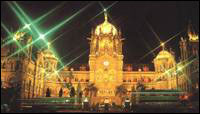 |
CHOWPATTY
BEACH
Chowpatty, literally meaning four channels,
is situated at the end of Marine Drive at the foot of Malabar
Hill. It witnesses great religious ceremonies, including the
Ganesh festival in early
September and the colourful festival of boats which marks
the end of the monsoon. There are numerous food stalls selling
bhelpuri (a Mumbai speciality).
|
CHOR BAZAAR
Chor Bazaar is commonly known as Thieves'Market,
a name coined by the British but perhaps mistakenly. It is
also thought that the original name was Shor Bazaar (Noisy
Market) which aptly described the yelling and shouting of
the local traders on Mutton Street while selling their second
hand household goods. Today, it is a hustling bustling market
selling an eclectic range of new and old furniture and bric-a-brac.
The traders, whose families have been in this business for
generations, scour the countryside buying goods to sell in
the market.You must visit Chor Bazaar.
|
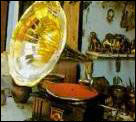 |
MARINE DRIVE
This is Mumbai's pride. It is a popular
promenade and is Mumbai's favourite spot for watching the
sun setting over the Arabian Sea. It is fondly called the
"Queen's Necklace" because of the dramatic curve
of its streetlights at night. Horse drawn Victoria rides are
available from either ends of the promenade. Nearest station
is Churchgate (Western Railway).
|
 |
TOWN
HALL
This is Mumbai's most distinguished
example of neoclassical architecture. Completed in 1833 and
designed by Col. Thomas Cowper R looks down on Horniman Circle,
constructed 35 years later. The central garden was laid out
by Rienzi Halton in 1869 on what was Old Bombay Green. The
library contains many ancient books and manuscripts along
with bronze and mar' ble sculptures of prominent Mumbai personalties.
Nearest station is C.S.T (VT) (Central Railway).
|
HANGING
GARDENS
Built in 1880 and renovated in 1921,
the Hanging Gardens are also known as the Pherozeshah Mehta
Gardens. They were landscaped on top of three reservoirs which
store 30 million gallons of Potable water supplied to the
city. Joggers and walkers regularly use these well maintained
gardens and lush green surroundings. Nearest station is Grant
Road (Western Railway).
|
KAMALA
NEHRU PARK
This children's park is opposite the
Hanging Gardens and was built in 1952 after the wife of India's
first Prime Minister, Pandit Jawaharlal Nehru. The park covers
an area of 4,000 sq. yds. and offers a magnificent view of
Marine Drive. There are lovely shadea pavilions covered with
flowers and plants if one wants seclusion. Nearest station
is Grant Road (Western Railway).
|
MAHALAXMI RACE
COURSE
Situated at Mahalaxmi, opp. The Haji
Ali Dargha, this world class race course was built under the
enthusiastic direction of Major J. E.Hughes. There are two
enclosures, one for Members and the other for the general
public. The Indian Derby is always in February. Mumbai's horse-racing
season runs from November to April. The big races are major
social occasions. Nearest station is Mahalaxmi (Western Railway).
|
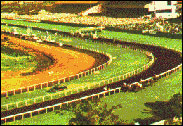 |
NATIONAL
GALLERY OF MODERN ART
C.J. Public Hall, Opp. Prince of Wales
Museum, M.G. Road.
|
NEHRU
PLANETARIUM
The Nehru Planetarium was inaugurated
by our late Prime Minister, Mrs. Indira Gandhi, on 3 March,1977
as a memorial to her father, Pandft Jawaharlal Nehru. In the
last 17 years, 6 million people have visited the planetarium.
The education programmes for children have been highly appreciated.
It exhibits collections of lunar and astronomical photographs.
Nearest station is Mahalaxmi (Western Railway).
|
NEHRU CENTRE
The Nehru Centre was designed by the
renowned architect M. Kadri and houses the 'Discovery
of India Exposition'. The design of the building is said to
embody Nehru's vision of lndia's step-by-step rise from an
agricultural nation to a modern industrialised state. The'Discovery
of lndia's exposition tracks lndia's history from prehistoric
times to Independence in 1947. Three dimensional replicas
of major architectural and artistic works, diorama, photographs
and audio visual are displayed. Nearest station is Mahalaxmi
(Western Railway). |
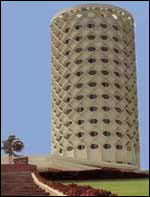 |